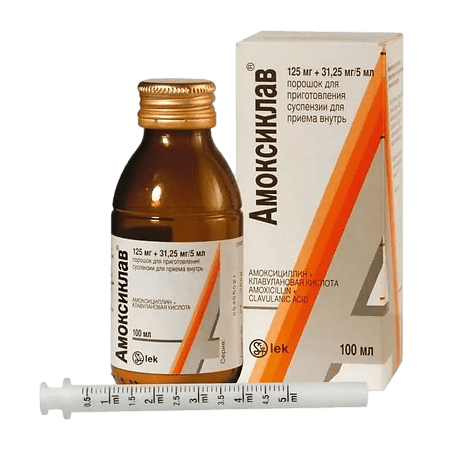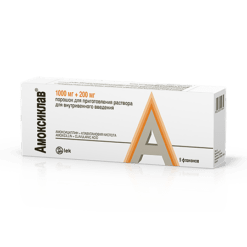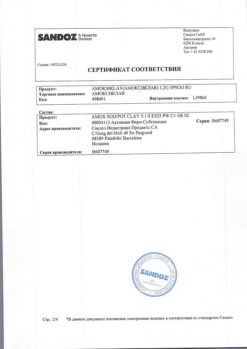No products in the cart.
Amoxiclav, 125 mg+31, 25 mg/5 ml 100 ml
€1.00
Out of stock
(E-mail when Stock is available)
Description
Pharmacological action Pharmacological action – broad spectrum antibacterial, bactericidal.
Pharmacodynamics
The drug Amoxiclav® is a combination of amoxicillin and clavulanic acid.
Amoxicillin is a semisynthetic penicillin (beta-lactam antibiotic) that inhibits one or more enzymes (often referred to as penicillin-binding proteins, PBPs) in the peptidoglycan biosynthesis pathway, which is an integral structural component of the bacterial cell wall. Inhibition of peptidoglycan synthesis leads to loss of cell wall strength, which usually causes lysis and cell death of microorganisms.
Amoxicillin is degraded by the action of beta-lactamases produced by resistant bacteria, so that the spectrum of activity of amoxicillin does not include microorganisms that produce these enzymes.
Clavulanic acid is a beta-lactam that is structurally related to penicillins. It inhibits some beta-lactamases, thereby preventing inactivation of amoxicillin and broadening its spectrum of activity to include bacteria normally resistant to amoxicillin as well as other penicillins and cephalosporins. Clavulanic acid itself has no clinically significant antibacterial activity.
The drug Amoxiclav® has a bactericidal effect in vivo on the following microorganisms:
– Gram-positive aerobes – Staphylococcus aureus*, Streptococcus pneumoniae, Streptococcus pyogenes;
– Gram-negative aerobes – Enterobacter spp.**, Escherichia coli*, Haemophilus influenzae*, species of the genus Klebsiella*, Moraxella catarrhalis* (Branhamella catarrhalis).
The drug Amoxiclav® has a bactericidal effect in vitro against the following microorganisms (but clinical significance is still unknown):
– Gram-positive aerobes – Bacillis anthracis*, species of the genus Corynebacterium, Enterococcus faecalis*, Enterococcus faecium*, Listeria monocytogenes, Nocardia asteroides, coagulazonegative staphylococci* (including Staphylococcus epidermidis), Streptococcus agalactiae, other species of the genus Streptococcus, Streptococcus viridans;
– gram-positive anaerobes – species of the genus Clostridium, species of the genus Peptococcus, species of the genus Peptostreptococcus;
– gram-negative aerobes – Bordetella pertussis, species of the genus Brucella, Gardnerella vaginalis, Helicobacter pylori, species of the genus Legionella, Neisseria gonorrhoeae*, Neisseria meningitidis*, Pasteurella multocida, Proteus mirabilis*, Proteus vulgaris*, species of the genus Salmonella*, species of the genus Shigella*, Vibrio cholerae, Yersinia enterocolitica*;
– gram-negative anaerobes – species of the genus Bacteroides* (including Bacteroides fragilis), species of the genus Fusobacterium*;
– others – Borrelia burgdorferi, Chlamydia spp., Leptospira icterohaemorrhagiae, Treponema pallidum.
* Some strains of these bacterial species produce beta-lactamases, which contributes to their insensitivity to amoxicillin monotherapy.
** Most strains of these bacteria are resistant to the amoxicillin/clavulanic acid combination in vitro, but the clinical effectiveness of this combination has been demonstrated in the treatment of urinary tract infections caused by these strains.
Pharmacokinetics
The main pharmacokinetic parameters of amoxicillin and clavulanic acid are similar. Amoxicillin and clavulanic acid are well soluble in aqueous solutions with physiological pH value and after oral administration of Amoxiclav® are quickly and completely absorbed from the gastrointestinal tract. Absorption of the active substances – amoxicillin and clavulanic acid – is optimal when the drug is taken at the beginning of a meal.
The bioavailability of amoxicillin and clavulanic acid after oral administration is about 70%.
The peak of plasma concentrations is reached approximately 1 hour after ingestion. Values of Cmax for amoxicillin (depending on the dose) are 3-12 mcg/ml, for clavulanic acid – about 2 mcg/ml.
The Cmax in plasma after a bolus injection of 1.2 g (1000+200 mg) of the drug is 105.4 mg/L for amoxicillin and 28.5 mg/L for clavulanic acid.
When using Amoxiclav® plasma concentrations of amoxicillin/clavulanic acid are similar to those when administering orally the corresponding doses of amoxicillin or clavulanic acid separately in equivalent doses.
The two components are characterized by sufficient Vd in various organs, tissues and body fluids (including lungs, abdominal cavity organs; fat, bone and muscle tissues; pleural, synovial and peritoneal fluids; skin, bile, urine, purulent secretions, sputum, interstitial fluid).
The plasma protein binding is moderate – 25% for clavulanic acid and 18% for amoxicillin.
The Vd is approximately 0.3-0.4 L/kg for amoxicillin and approximately 0.2 L/kg for clavulanic acid.
Amoxicillin and clavulanic acid do not penetrate the blood-brain barrier in non-inflamed cerebral membranes.
Amoxicillin (like most penicillins) is excreted with breast milk. Trace amounts of clavulanic acid are also found in breast milk. Amoxicillin and clavulanic acid penetrate the placental barrier.
Amoxicillin is excreted mainly by the kidneys, whereas clavulanic acid is excreted through both renal and extrarenal mechanisms. After a single oral administration of one tablet of 250+125 mg or 500+125 mg, approximately 60-70% of amoxicillin and 40-65% of clavulanic acid are excreted unchanged in the urine during the first 6 h. About 10-25% of the initial dose of amoxicillin is excreted with urine as inactive penicillic acid. Clavulanic acid in humans undergoes intensive metabolism to form 2,5-dihydro-4-(2-hydroxyethyl)-5-oxo-1H-pyrrol-3-carboxylic acid and 1-amino-4-hydroxy-butane-2-one and is excreted with urine and feces.
The average T1/2 of amoxicillin/clavulanic acid is approximately 1 h, the average total clearance is approximately 25 L/h in healthy patients. Various studies have found that urinary excretion of amoxicillin within 24 h is approximately 50-85%, clavulanic acid 27-60%. The greatest amount of clavulanic acid is excreted during the first 2 hours after intake.
Patients with impaired liver function
In patients with severe renal impairment the T1/2 is increased to 7.5 h for amoxicillin and to 4.5 h for clavulanic acid.
In patients with hepatic impairment the dose of the drug should be adjusted with caution: constant monitoring of the liver condition is necessary.
The two components are eliminated by hemodialysis and minor amounts by peritoneal dialysis.
Indications
Indications
Infections caused by susceptible strains of microorganisms:
– Upper respiratory tract and ENT (including.
– lower respiratory tract (including acute and chronic sinusitis, acute and chronic otitis media, glossopharyngeal abscess, tonsillitis, pharyngitis).ч. acute bronchitis with bacterial superinfection, chronic bronchitis, pneumonia;
– urinary tract (e.g. cystitis, urethritis, pyelonephritis);
– in gynecology;
Active ingredient
Active ingredient
Composition
Composition
Powder for the preparation of suspension for oral
5 ml of suspension:
the active ingredients:
amoxicillin (in the form of trihydrate) – 125 mg,
amoxicillin (in the form of trihydrate) – 31.25 mg.
excipients: citric acid (anhydrous) – 2.167 mg; sodium citrate (anhydrous) – 8.335 mg; sodium benzoate – 2.085 mg; MCC and sodium carmellose – 28.1 mg; xanthan gum – 10 mg; Colloidal silica – 16.667 mg; silicon dioxide – 0.217 g; sodium saccharinate – 5.5 mg; mannitol – 1250 mg; strawberry flavoring – 15 mg.
How to take, the dosage
How to take, the dosage
Ingestion
The daily dose of 125+31.25mg/5 ml and 250+62.5mg/5 ml suspensions (to facilitate correct dosing, each package of 125+31.25mg/5 ml and 250+62.5mg/5 ml suspensions contains a dosing pipette graduated for 5 ml, with a 0.1 ml graduation scale or a dosing spoon with a 5 ml capacity, with 2.5 and 5 ml ring markings in the cavity).
Infants and children under 3 months – 30 mg/kg/day (for amoxicillin) divided into 2 doses (every 12 hours).
The dosing of Amoxiclav® by pipette – calculation of single doses for the treatment of infections in infants and children under 3 months of age (Table 3).
Table 3
Children over 3 months – from 20 mg/kg for mild to moderate infections to 40 mg/kg for severe infections and lower respiratory tract infections, otitis media, sinusitis (for amoxicillin) per day, divided into 3 doses (every 8 hours).
The dosage of Amoxiclav® by pipette – calculation of single doses for the treatment of mild and moderate infections in children over 3 months (at the rate of 20 mg/kg/day (for amoxicillin) (Table 4).
Table 4
Interaction
Interaction
For all dosage forms
Antacids, glucosamine, laxatives, aminoglycosides slow absorption, ascorbic acid increases absorption.
Diuretics, allopurinol, phenylbutazone, NSAIDs and other drugs that block tubular secretion (probenecid) increase the concentration of amoxicillin (clavulanic acid is eliminated mainly by glomerular filtration).
The concomitant use of Amoxiclav® and methotrexate increases the toxicity of methotrexate.
The co-administration with allopurinol increases the incidence of exanthema. Concomitant use with disulfiram should be avoided.
Decreases the effectiveness of drugs in the metabolism of which PABA is formed; ethinyl estradiol – risk of breakthrough bleeding.
The literature describes rare cases of increased INR in patients when coadministering acenocoumarol or warfarin and amoxicillin. If concomitant use with anticoagulants is necessary, PV or INR should be closely monitored when prescribing or withdrawing the drug.
The combination with rifampicin is antagonistic (mutual weakening of the antibacterial effect). The preparation Amoxiclav® should not be used simultaneously in combination with bacteriostatic antibiotics (macrolides, tetracyclines), sulfonamides because of possible decrease of effectiveness of Amoxiclav® preparation.
The drug Amoxiclav® reduces the effectiveness of oral contraceptives.
For dispersible tablets and powder for preparation of suspension for oral administration additionally
Increases the effectiveness of indirect anticoagulants (by inhibiting intestinal microflora, reduces the synthesis of vitamin K and prothrombin index). In some cases, administration of the drug may prolong PV, in this regard, caution should be exercised when concomitant use of anticoagulants and the drug Amoxiclav® Quicktab.
Probenecid decreases excretion of amoxicillin, increasing its serum concentration.
In patients receiving mycophenolate mofetil, a decrease of approximately 50% in the concentration of the active metabolite, mycophenolic acid, was observed after starting the combination of amoxicillin and clavulanic acid before the next dose of the drug. Changes in this concentration cannot accurately reflect overall changes in mycophenolic acid exposure.
Special Instructions
Special Instructions
Amoxiclav is prescribed with caution in patients prone to allergic reactions, as well as in patients with known hypersensitivity to cephalosporin antibiotics, since there is a risk of cross-sensitivity.
Simultaneous use with drugs to reduce blood clotting leads to enhancement of the action of the latter. The drug weakens the effect of aminoglycoside antibiotics. During long-term treatment it is necessary to monitor the hematopoietic, hepatic and renal function.
Contraindications
Contraindications
– hypersensitivity to the components of the drug;
– hypersensitivity to penicillins, cephalosporins and other beta-lactam antibiotics in the history;
– cholestatic jaundice and/or other liver dysfunction caused by taking amoxicillin/clavulanic acid, in the history;
– infectious mononucleosis and lympholeukemia.
Side effects
Side effects
Blood and lymphatic system disorders: rare – reversible leukopenia (including neutropenia), thrombocytopenia; very rare – eosinophilia, thrombocytosis, reversible agranulocytosis, increased bleeding time and reversible increase in PV, anemia, including reversible hemolytic anemia.including reversible hemolytic anemia.
Immune system disorders: frequency unknown – angioedema, anaphylactic reactions, allergic vasculitis, syndrome similar to serum sickness.
Nervous system disorders: infrequent – dizziness, headache; very rare – insomnia, agitation, anxiety, behavioral changes, reversible hyperactivity, seizures; seizures may be observed in patients with impaired renal function and those receiving high doses of the drug.
Gastrointestinal disorders: often – loss of appetite, nausea, vomiting, diarrhea. Nausea is more often observed when high doses are taken orally. If gastrointestinal disorders are confirmed, they can be eliminated if the drug is taken at the beginning of a meal; infrequently – indigestion; very rare – antibiotic-associated colitis induced by taking antibiotics (including pseudomembranous and hemorrhagic colitis), black “hairy” tongue, gastritis, stomatitis. Children have very rarely seen discoloration of the surface layer of tooth enamel. Oral care can help prevent discoloration of tooth enamel.
Skin disorders: infrequent – skin rash, pruritus, urticaria; rare – erythema multiforme exudative; frequency unknown – Stevens-Johnson syndrome, toxic epidermal necrolysis, bullous exfoliative dermatitis, acute generalized exanthematous pustulosis.
Urinary system disorders: very rarely – crystalluria, interstitial nephritis, hematuria.
Hepatic and biliary tract disorders: infrequent – increase of ALT and/or AST activity (this phenomenon is observed in patients treated with beta-lactam antibiotics, but its clinical significance is unknown); Undesired liver disorders were observed mostly in men and elderly patients and may be associated with long-term therapy. These adverse events are very rarely observed in children.
The signs and symptoms listed usually occur during or immediately after completion of therapy, but in some cases may not occur for several weeks after completion of therapy. The adverse events are generally reversible. Liver adverse events can be severe, in exceptionally rare cases there have been reports of fatal outcomes. In almost all cases these were patients with severe comorbidities or patients receiving concomitant potentially hepatotoxic drugs. Very rarely – increased ALP activity, elevated bilirubin levels, hepatitis, cholestatic jaundice (noted with concomitant therapy with other penicillins and cephalosporins).
Others: frequent – candidiasis of the skin and mucous membranes; frequency unknown – growth of insensitive microorganisms.
Overdose
Overdose
There have been no reports of death or life-threatening side effects due to overdose of the drug.
Symptoms: in most cases – gastrointestinal disorders (abdominal pain, diarrhea, vomiting), possibly also anxiety, insomnia, dizziness, in single cases – seizures.
Treatment: In case of overdose the patient must be under medical supervision; treatment is symptomatic.
In case of recent intake (less than 4 hours) of the drug it is necessary to perform gastric lavage and prescribe activated charcoal to reduce absorption. Amoxicillin/clavulanate potassium is removed by hemodialysis.
Pregnancy use
Pregnancy use
In pregnancy and lactation, Amoxiclav® is used only if the estimated benefit to the mother exceeds the potential risk to the fetus and child.
Amoxiclav® Quicktab can be administered during pregnancy in the presence of clear indications.
Amoxicillin and clavulanic acid penetrate into breast milk in small amounts.
Similarities
Similarities
Additional information
| Shelf life | 2 years |
|---|---|
| Conditions of storage | Store in a dry place out of the reach of children at a temperature not exceeding 25°C. After preparation, the oral suspension should be stored at 2°C to 8°C in a tightly closed bottle and used within 7 days. |
| Manufacturer | Lek d.d., Slovenia |
| Medication form | Powder for oral suspension |
| Brand | Lek d.d. |
Other forms…
Related products
Buy Amoxiclav, 125 mg+31, 25 mg/5 ml 100 ml with delivery to USA, UK, Europe and over 120 other countries.

















